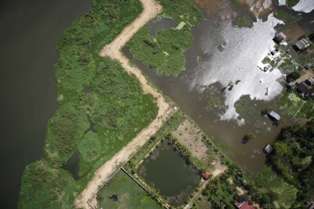IUCN demonstrates the application of environmental flows to support the health of aquatic ecosystems and the well-being of people who depend on them. Where dams and abstraction regulate flows, environmental flow regimes integrate the needs of people and nature according to the priorities negotiated by stakeholders.
On the, Huong, Tempisque, Limpopo and Pangani rivers, from Vietnam to Costa Rica to Zimbabwe to Tanzania, WANI has helped integrate environmental flows into policy and practice. Stakeholders, basin managers and policy makers alike learned, using the WANI toolkit FLOW, that including ecosystems in water allocation decisions can mitigate the impacts of dams and support practical, long-lasting development.
South-East Asia
WANI demonstrated that environmental flows catalyse development of knowledge, capacities and institutions needed to move beyond IWRM planning to implementation. In the Huong Basin (Vietnam), a flow assessment made clear how changes in river flow affect both economic returns and ecosystem health. Basin authorities were able to determine which flow options accommodate economic goals while protecting downstream ecosystems and their services. As a result of the increasing awareness and capacity created by the flow assessment, environmental flows have been incorporated into planning for the Huong Basin by the provincial People’s Committee and, at national level, the government has included environmental flows in the natural resources strategy and in water sharing plans.
Central America
Environmental Flows Assessments are normally carried out to predict the long-term impacts of modified flow regimes on the ecosystems and communities downstream of water resources infrastructure. A preliminary determination for the Tempisque River in Costa Rica was performed so that social actors could initiate a dialogue leading to agreement over mitigation and compensation for affected subsistence users of the river. The study made a contribution in that it characterised the magnitude of the climatic variables and their effects on the flow regime of the river, as well as the impact of using water for irrigation upstream. The following step in any environmental flows implementation process is then to design a long-term monitoring programme to assess if agreed flows are delivered and if they are achieving the desired river condition.
East Africa
Implementation of the 2002 Tanzanian National Water Policy was piloted in the Pangani Basin (Tanzania) through the assessment of flows needed for all sectors including the environment. Stakeholders continue to gain an understanding of social, economic and environmental trade-offs for different water allocations. Alongside the ongoing creation of new stakeholder forums beginning to coordinate water management from community to basin levels, the Pangani Basin Water Office is now planning its water future with a view to making the Pangani and its people more resilient to the growing threat of water scarcity. WANI is helping other basins in Tanzania to follow suit.
Southern Africa
The Limpopo Basin is one of the most developed in southern Africa. As such, the natural flow regime and ecology of the river course has been modified as a result of the construction of numerous dams on tributaries. Surface flow in the main channel ceases entirely in the winter dry season although water continues to flow in the deeper alluvial deposits. Designated as the site for demonstrating an environmental flows assessment, stakeholders in the Mzingwane Catchment in South Western Zimbabwe understood that environmental flows does not mean providing water when it is normally dry but rather to try and mimic the natural flow pattern as closely as possible. In addition, the Limpopo project contributed to the adaptation of globally established environmental flows methodologies in Southern Africa.
WANI has supported learning on environmental flows in Asia, Africa and Latin America. This has catalysed the incorporation of environmental flows into river basin projects supported by the Global Environment Facility (GEF), as well as adoption into legal frameworks, including the draft water law of Costa Rica. Globally, IUCN and partners are mobilising learning, knowledge sharing and adaptation of environmental flows approaches to the regional context through the Global Environmental Flows Network.
Environmental flows uses negotiation among stakeholders to improve river basin sustainability, by integrating ecosystem needs with priorities for poverty reduction and economic development. Strengthening support for application of environmental flows in policy and law drives development of the knowledge, capacities and institutions needed to implement IWRM.
Further Information
Case Study: Environmental Flows
The Environmental Flows Network website.
